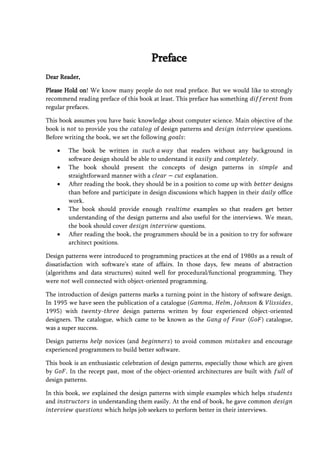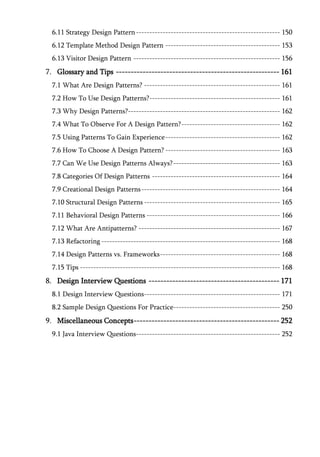Peeling design patterns
- 1. -To All Our Readers
- 2. Copyright ÂĐ by All rights reserved. Designed by Copyright ÂĐ2012 Career Monk Publications. All rights reserved. All rights reserved. No part of this book may be reproduced in any form or by any electronic or mechanical means, including information storage and retrieval systems, without written permission from the publisher or author.
- 3. Acknowledgements First and foremost, we would like to thank our , and dear whose support and encouragement throughout our lives have made it possible for us to build the skill set necessary to succeed. We would like to express our gratitude to many people who saw us through this book, to all those who provided support, talked things over, read, wrote, offered comments, allowed us to quote their remarks and assisted in the editing, proofreading and design. In particular, we would like to thank the following individuals. ï§ , Founder, Vegayan Systems Pvt. Ltd. ï§ , Senior Manager, Microsoft India Pvt. Ltd. ï§ , IIT Kanpur, Mentor Graphics Pvt. Ltd. ï§ , IIT Kanpur, Microsoft India Pvt. Ltd. ï§ , Nokia Pvt. Ltd. ï§ , IIT Bombay ï§ , IIT Bombay, Google India Pvt. Ltd. ï§ , IIT Bombay, De-Shaw India Pvt. Ltd. ï§ , IIT Roorkee, Microsoft India Pvt. Ltd. ï§ , Founder, StockMonks Pvt. Ltd. ï§ , IIT Kharagpur, Xilinx Pvt. Ltd. ï§ , Founders, Impression Design Studio Pvt. Ltd. -ðððð ðððððððĢðð ð ð ðð ðððð -ððððð ðð ð ðūðððĒðððð ð Ph. D., Director, School of IT, M. Tech, ðžðžð ðĩðððððĶ JNTU, Hyderabad Founder of ðķððððððððð ððð
- 5. Preface Dear Reader, Please Hold on! We know many people do not read preface. But we would like to strongly recommend reading preface of this book at least. This preface has something from regular prefaces. This book assumes you have basic knowledge about computer science. Main objective of the book is to provide you the of design patterns and questions. Before writing the book, we set the following : ï· The book be written in that readers without any background in software design should be able to understand it and . ï· The book should present the concepts of design patterns in and straightforward manner with a explanation. ï· After reading the book, they should be in a position to come up with designs than before and participate in design discussions which happen in their office work. ï· The book should provide enough examples so that readers get better understanding of the design patterns and also useful for the interviews. We mean, the book should cover questions. ï· After reading the book, the programmers should be in a position to try for software architect positions. Design patterns were introduced to programming practices at the end of as a result of dissatisfaction with softwareâs state of affairs. In those days, few means of abstraction (algorithms and data structures) suited well for procedural/functional programming. They were well connected with object-oriented programming. The introduction of design patterns marks a turning point in the history of software design. In we have seen the publication of a catalogue ( , , & , ) with - design patterns written by four experienced object-oriented designers. The catalogue, which came to be known as the ( ) catalogue, was a super success. Design patterns novices (and ) to avoid common and encourage experienced programmers to build better software. This book is an enthusiastic celebration of design patterns, especially those which are given by . In the recept past, most of the object-oriented architectures are built with of design patterns. In this book, explained the design patterns with simple examples which helps and in understanding them easily. At the end of book, he gave common which helps job seekers to perform better in their interviews.
- 6. A thorough understanding of the design patterns, processes, and methods in this book will likewise help you develop better software applications and infrastructure. If you want thorough coverage of the key patterns then read this book. We have learned much from it and I am confident that you will too. As a job seeker if you read complete book with good understanding, we are sure you will challenge the interviewers and that is the objective of this book. This book is very much useful for the students of engineering degree and masters during their academic preparations. All the chapters of this book contain theory and their related problems. If you read as a student preparing for competition exams, content of this book covers all the required topics in full details. It is that, at least reading of this book is required to get full understanding of all the topics. In the readings, you can directly go to any chapter and refer. Even though, enough readings were given for correcting the errors, due to human tendency there could be some minor typos in the book. If any such typos found, they will be updated at www. .com. We request you to constantly monitor this site for any corrections, new problems and solutions. Also, please provide your valuable suggestions at: . Wish you all the best. Have a nice reading. -ðððð ðððððððĢðð ð ð ðð ðððð -ððððð ðð ð ðūðððĒðððð ð Ph. D., Director, School of IT, M. Tech, ðžðžð ðĩðððððĶ JNTU, Hyderabad Founder of ðķððððððððð ððð
- 7. Table of Contents 1. Introduction-------------------------------------------------------------- 11 1.1 What Is This Book About? ----------------------------------------------------- 11 1.2 Little History of Design Patterns ----------------------------------------------- 11 1.3 Should I Take This Book? ------------------------------------------------------ 12 1.4 Is It Useful For Interviews? ---------------------------------------------------- 12 1.5 How To Use This book? -------------------------------------------------------- 12 1.6 Organization Of Chapters ------------------------------------------------------ 13 1.7 Source Code Disclaimer -------------------------------------------------------- 14 1.8 Tools Used For Book ----------------------------------------------------------- 14 2. UML Basics --------------------------------------------------------------- 15 2.1 What Is UML? ------------------------------------------------------------------ 15 2.2 Why UML? --------------------------------------------------------------------- 15 2.3 UML Notations ----------------------------------------------------------------- 15 2.4 Object Oriented Concepts ------------------------------------------------------ 16 2.5 OO Analysis and Design (OOAD) --------------------------------------------- 18 2.6 UML Building Blocks and Notations ------------------------------------------- 19 2.7 Things--------------------------------------------------------------------------- 19 2.8 Relationship -------------------------------------------------------------------- 25 2.9 UML Diagrams ----------------------------------------------------------------- 29 3. Design Patterns Introduction -------------------------------------------- 38 3.1 What are Design Patterns? ----------------------------------------------------- 38 3.2 Little History of Design Patterns ----------------------------------------------- 38 3.3 Why Design Patterns?---------------------------------------------------------- 38 3.4 Categories Of Design Patterns ------------------------------------------------- 39 3.5 What To Observe For A Design Pattern? -------------------------------------- 40 3.6 Using Patterns To Gain Experience -------------------------------------------- 40
- 8. 3.7 Can We Use Design Patterns Always? ------------------------------------------ 41 3.8 Design Patterns vs. Frameworks ------------------------------------------------ 41 4. Creational Patterns ------------------------------------------------------ 43 4.1 Creational Design Patterns ------------------------------------------------------ 43 4.2 Categories Of Creational Design Patterns -------------------------------------- 43 4.3 Factory Method Design Pattern ------------------------------------------------ 44 4.4 Abstract Factory Design Pattern ------------------------------------------------ 48 4.5 Builder Design Pattern ---------------------------------------------------------- 52 4.6 Singleton Design Pattern -------------------------------------------------------- 60 4.7 Prototype Design Pattern ------------------------------------------------------- 65 5. Structural Patterns ------------------------------------------------------- 70 5.1 Structural Design Patterns ------------------------------------------------------ 70 5.2 Categories Of Structural Design Patterns --------------------------------------- 70 5.3 Adapter Design Pattern --------------------------------------------------------- 71 5.4 Bridge Design Pattern ----------------------------------------------------------- 77 5.5 Composite Design Pattern ------------------------------------------------------ 80 5.6 Decorator Design Pattern ------------------------------------------------------- 86 5.7 Facade Design Pattern----------------------------------------------------------- 93 5.8 Proxy Design Pattern ----------------------------------------------------------- 99 5.9 Flyweight pattern ------------------------------------------------------------- 102 6. Behavioral Patterns ----------------------------------------------------- 109 6.1 Behavioral Design Patterns --------------------------------------------------- 109 6.2 Categories Of Behavioral Design Patterns ------------------------------------ 109 6.3 Chain Of Responsibility Design Pattern -------------------------------------- 110 6.4 Command Design Pattern ----------------------------------------------------- 116 6.5 Interpreter Design Pattern ---------------------------------------------------- 121 6.6 Iterator Design Pattern -------------------------------------------------------- 125 6.7 Mediator Design Pattern ------------------------------------------------------ 132 6.8 Memento Design Pattern ----------------------------------------------------- 138 6.9 Observer Design Pattern ------------------------------------------------------ 142 6.10 State Design Pattern --------------------------------------------------------- 147
- 9. 6.11 Strategy Design Pattern ------------------------------------------------------ 150 6.12 Template Method Design Pattern ------------------------------------------- 153 6.13 Visitor Design Pattern ------------------------------------------------------- 156 7. Glossary and Tips ------------------------------------------------------- 161 7.1 What Are Design Patterns? --------------------------------------------------- 161 7.2 How To Use Design Patterns?------------------------------------------------- 161 7.3 Why Design Patterns?--------------------------------------------------------- 162 7.4 What To Observe For A Design Pattern? ------------------------------------- 162 7.5 Using Patterns To Gain Experience ------------------------------------------- 162 7.6 How To Choose A Design Pattern? ------------------------------------------- 163 7.7 Can We Use Design Patterns Always? ---------------------------------------- 163 7.8 Categories Of Design Patterns ------------------------------------------------ 164 7.9 Creational Design Patterns ---------------------------------------------------- 164 7.10 Structural Design Patterns --------------------------------------------------- 165 7.11 Behavioral Design Patterns -------------------------------------------------- 166 7.12 What Are Antipatterns? ----------------------------------------------------- 167 7.13 Refactoring ------------------------------------------------------------------- 168 7.14 Design Patterns vs. Frameworks --------------------------------------------- 168 7.15 Tips --------------------------------------------------------------------------- 168 8. Design Interview Questions -------------------------------------------- 171 8.1 Design Interview Questions--------------------------------------------------- 171 8.2 Sample Design Questions For Practice---------------------------------------- 250 9. Miscellaneous Concepts ------------------------------------------------- 252 9.1 Java Interview Questions------------------------------------------------------ 252
- 10. PEELING DESIGN PATTERNS (FOR BEGINNERS AND INTERVIEWS) Other Titles by ððððð ðð ð ðūðððĒðððð ð Success keys for Big Job Hunters Data Structures and Algorithms Made Easy (C/C++) Data Structures and Algorithms Made Easy in Java Data Structures and Algorithms for GATE Coding Interview Questions









